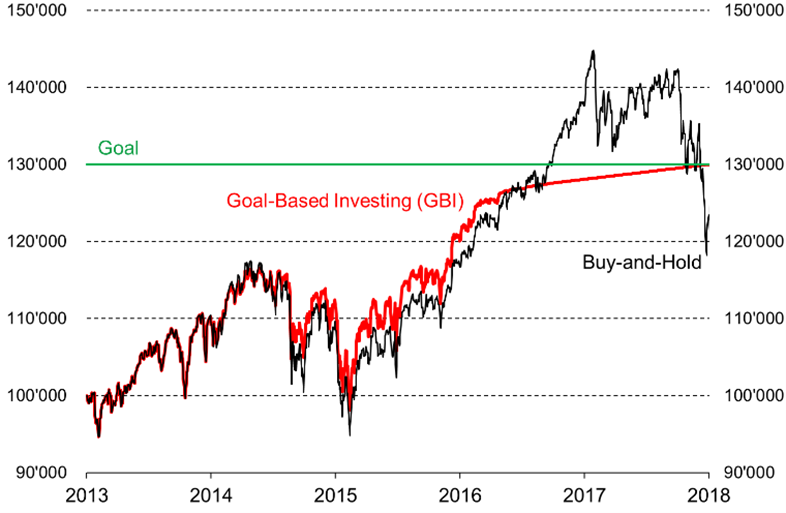Most investors manage their wealth for the long term, trying to maximize their returns for the risk that they are willing to take. But what if you have a financial goal that you want to reach by a certain, perhaps not that long-term, deadline? To answer this question, MBaer Merchant Bank launched the Project "Goal-Based Investing for retirement planning" in co-operation with Dr. Marcus Wunsch from ZHAW. Financial support from Innosuisse, the Swiss Innovation Agency, is gratefully acknowledged.
Dr. Francesco Mandalà (MBaer Chief Investment Officer)
Dr. Marcus Wunsch (ZHAW Senior Lecturer)

Most of us have goals in their lives: losing weight, getting the next promotion, marrying one’s sweetheart, travelling to distant corners of the world. Yet, when it comes to investing, banks will not usually ask for your financial goals. Rather, they will determine your risk preferences (in terms of “volatility”) and then propose a portfolio that, at least in theory, yields maximal returns and lets you sleep at night.
How can clients’ financial goals be incorporated into the investment process? It turns out that we do not need to reinvent the wheel to do so. Around the turn of the millennium[1], Sid Browne (1999) and Föllmer & Leukert (2000) did some groundbreaking work on Goal-Based Investing (GBI). More recent contributions employ machine learning techniques, see for instance Krabichler & Wunsch (2024). These GBI approaches dynamically and systematically allocate wealth between a risky asset and a non-defaultable bond. For example, if the financial goal is easily within reach, but still much time left, GBI will reduce the allocation to the risky asset and, correspondingly, increase the allocation to the non-defaultable bond.
Since any equity portfolio can be regarded as a risky asset, GBI can be integrated into the investment process by shifting wealth allocations between a client’s portfolio and a suitable non-defaultable bond, depending on the Actual Funded Status (AFS) of the financial goal.[2] A crucial element for calculating the AFS are inflation expectations, which are particularly important – and difficult – the farther the goal lies in the future. The estimation of future inflation risk is a delicate exercise that requires both macroeconomic and quantitative expertise. Clearly, the investment process for GBI needs a close relationship between the client and her wealth manager. Should the AFS fall below a critical level that essentially nullifies the probability of reaching the intended financial goal e.g. due to a market's sudden crash, then both client and wealth manager will have to discuss whether to reduce the financial goal, or to inject additional cash into the portfolio. Importantly, the GBI paradigm can also be modified to systematically beat passive benchmarks by a given percentage.
An illustrative example
Assume that you want to have CHF 130’000 in five years’ time to finance your child's college fees. You do not want to gamble on the future of your child's education so, in the spirit of goal-based investing, you only take as much risk as you should. Right now, you can put aside Swiss francs. You decide to manage your invested money using the S&P 500 equity index hedged in CHF and a non-defaultable bond yielding 1.5%. What is the best dynamic allocation strategy to attain your goal? GBI offers a transparent and systematic solution based on maximizing the probability of reaching this financial goal. In Figure 1, we illustrate this strategy in a backtest covering the period from January 2013 to December 2018, assuming an initial capital of CHF 100'000.
Figure 1: Goal-based investing (GBI) versus Buy-and-Hold.
Source: Authors' calculations based on Bloomberg data
Clearly, GBI worked perfectly for this period. While Buy-and-Hold outperformed GBI until October 2018, it suffered from the market turmoil starting thereafter, and ended up falling short of the intended goal. GBI, on the other hand, reached the goal by going risk-off in mid-2017. Importantly, the temporary outperformance of the Buy-and-Hold strategy has been achieved by taking too much risk, i.e., risk exceeding the level of the strategy that maximizes the probability of attaining the goal.
To be sure, not even GBI can guarantee that a financial goal will be attained – the optimal goal-reaching probability might still be very low due to, e.g., an insufficient initial funding status.
Nevertheless, GBI provides a solid mathematical foundation and valuable guidance on dynamic asset allocation.
As a next step, we plan to design and offer investment solutions and retirement saving solutions to our clients by applying the goal-based investing paradigm.
The authors would like to thank Mr. Mike Baer for encouragement and support for the project and Dr. Arun Muralidhar and Dr. Alberto Desirelli for helpful discussions and detailed comments.
[1]This sounds like quite a while ago but recall that Modern Portfolio Theory hails from 1952 and is still in use by many asset managers.
[2] We define the Actual Funded Status (AFS) of the financial goal as the current portfolio value divided by the present value of the financial goal.
